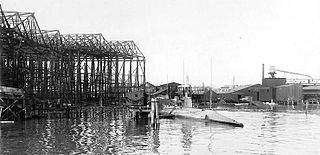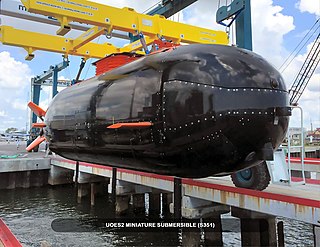Related Research Articles

A midget submarine is any submarine under 150 tons, typically operated by a crew of one or two but sometimes up to six or nine, with little or no on-board living accommodation. They normally work with mother ships, from which they are launched and recovered and which provide living accommodation for the crew and support staff.

USS K-3 (SS-34) was a K-class submarine built for the United States Navy during the 1910s.
Air-independent propulsion (AIP), or air-independent power, is any marine propulsion technology that allows a non-nuclear submarine to operate without access to atmospheric oxygen. AIP can augment or replace the diesel-electric propulsion system of non-nuclear vessels.

An autonomous underwater vehicle (AUV) is a robot that travels underwater without requiring continuous input from an operator. AUVs constitute part of a larger group of undersea systems known as unmanned underwater vehicles, a classification that includes non-autonomous remotely operated underwater vehicles (ROVs) – controlled and powered from the surface by an operator/pilot via an umbilical or using remote control. In military applications an AUV is more often referred to as an unmanned undersea vehicle (UUV). Underwater gliders are a subclass of AUVs.
The AN/BLQ-11 autonomous unmanned undersea vehicle is a torpedo tube-launched and tube-recovered underwater search and survey unmanned undersea vehicle (UUV) capable of performing autonomous minefield reconnaissance as much as 200 kilometers (120 mi) in advance of a host Los Angeles-, Seawolf-, or Virginia-class submarine.

An underwater glider is a type of autonomous underwater vehicle (AUV) that employs variable-buoyancy propulsion instead of traditional propellers or thrusters. It employs variable buoyancy in a similar way to a profiling float, but unlike a float, which can move only up and down, an underwater glider is fitted with hydrofoils that allow it to glide forward while descending through the water. At a certain depth, the glider switches to positive buoyancy to climb back up and forward, and the cycle is then repeated.

DSRV-1Mystic is a deep-submergence rescue vehicle that is rated to dive up to 5,000 feet. It was built by Lockheed for the US Navy at a construction cost of $41 million and launched 24 January 1970. It was declared fully operational in 1977 and named Mystic.

The Boeing A160 Hummingbird is an unmanned aerial vehicle (UAV) helicopter. Its design incorporates many new technologies never before used in helicopters, allowing for greater endurance and altitude than any helicopter currently in operation.

Unmanned underwater vehicles (UUV), also known as uncrewed underwater vehicles and underwater drones, are submersible vehicles that can operate underwater without a human occupant. These vehicles may be divided into two categories: remotely operated underwater vehicles (ROUVs) and autonomous underwater vehicles (AUVs). ROUVs are remotely controlled by a human operator. AUVs are automated and operate independently of direct human input.
The Type 925 Dajiang with NATO reporting name Dajiang, or 大江 in Chinese, meaning Great River, is a type of naval auxiliary ship belonging to the People's Republic of China. Each ship is usually equipped with up to two Type 7103 DSRV class Deep Submergence Rescue Vehicles (DSRVs). The ship is designed to replace the first People's Liberation Army Navy (PLAN) submarine tender PLANS Mount Tai, and the lead ship of the Dajiang class is the Changxingdao. The Type 925 is a submarine tender that can also be used as a submarine rescue ship, and hence, it is designated as a submarine support ship by Chinese.
B-90 Sarov also referred to as Sarov class, Russian designation Project 20120 Sargan, is a Russian special purpose diesel-electric submarine that uses a nuclear reactor as a supplementary power generator. The existence of the submarine was first revealed in 2007, when details about the boat were accidentally published on the Sarov, Nizhny Novgorod region's local government website as part of an account of a meeting with its commander. It serves in the Russian Navy's Northern Fleet and is being used as a technology demonstrator for testing of upgraded weapons and military equipment or as an intelligence collection boat.
Explorer autonomous underwater vehicle (AUV) is a Chinese AUV developed in the People's Republic of China (PRC), first entering service in November 1994. It should not be confused with another two Anglo-American AUVs that share the same name: the American Autonomous Benthic Explorer AUV (ABE) built by Woods Hole Oceanographic Institution, and the British Columbia-based International Submarine Engineering built Canadian Explorer AUV, which is based on its earlier ARCS AUV. Many Chinese AUVs later developed, such as Wukong, WZODA, CR series, Exploration series, Micro Dragon series, Sea Whale series, Submerged Dragon series AUVs, are all based on experienced gained from Explorer AUV.
Liquid Robotics is an American marine robotics corporation that designs, manufactures and sells the Wave Glider, a wave and solar powered unmanned surface vehicle (USV). The Wave Glider harvests energy from ocean waves for propulsion. With this energy source, Wave Gliders can spend many months at a time at sea, collecting and transmitting ocean data.

HMCS Windsor is a long-range hunter-killer (SSK) submarine of the Royal Canadian Navy, the second submarine of the Victoria class. She is named after the city of Windsor, Ontario. Built for the Royal Navy as the Upholder-class submarine HMS Unicorn she was purchased by Canada when the United Kingdom decided to move to an all-nuclear power fleet.

The REMUS series are autonomous underwater vehicles (AUVs) made by the Woods Hole Oceanographic Institution and designed by their Oceanographic Systems Lab (OSL). More recently REMUS vehicles have been manufactured by the spinoff company Hydroid Inc, which was a wholly owned subsidiary of Kongsberg Maritime. Hydroid was acquired by Huntington Ingalls Industries (HHI) in March 2020. The series are designed to be low cost, they have shared control software and electronic subsystems and can be operated from a laptop computer. They are used by civilians for seafloor mapping, underwater surveying, and search and recovery as well as by several navies for mine countermeasures missions.
The Knifefish is an autonomous unmanned underwater vehicle (UUV) under development by General Dynamics Mission Systems and Bluefin Robotics for the United States Navy. It is a propeller-driven minesweeping robot designed to replace the Navy's trained dolphins and sea lions after the retirement of the 50-year-old Marine Mammal Program in 2017. The Knifefish was first unveiled at a Navy exposition in April 2012, and was originally intended to operate in concert with the Navy's littoral combat ships (LCS) as part of a specialized counter-mine system.

The Dry Combat Submersible (DCS) is a midget submarine delivered to USSOCOM by Lockheed Martin.
Echo Voyager is an autonomous underwater vehicle (AUV) built by Boeing.
Echo Seeker is an autonomous underwater vehicle (AUV) built by Boeing.
HSU-001 is a class of Chinese unmanned underwater vehicle.
References
- ↑ "Navy Awards Phase I Of Orca XLUUV To Lockheed Martin And Boeing". Defense Daily. 29 September 2017. Retrieved 20 October 2020.
- 1 2 3 4 "Orca XLUUV". Naval Technology. Retrieved 20 October 2020.
- 1 2 "Boeing wins $43 million contract for autonomous submarines". Workboat. 21 February 2019. Retrieved 17 October 2020.
- 1 2 "The Navy is starting to put up real money for robot submarines". Los Angeles Times. 19 April 2019. Retrieved 20 October 2020.
- ↑ "Boeing Delivers First Orca XLUUV to U.S. Navy". Naval News. 2023-12-20.
- 1 2 3 "As U.S. Navy Plans for Unmanned Ships, Its Biggest Shipbuilder Adapts". The Maritime Executive. 12 October 2020. Retrieved 20 October 2020.